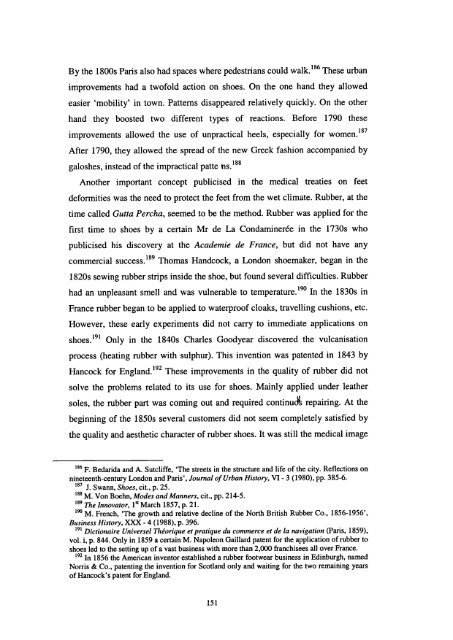The Boot and Shoe Trades in London and Paris in the Long Eighteenth Century
The Boot and Shoe Trades in London and Paris in the Long Eighteenth Century
The Boot and Shoe Trades in London and Paris in the Long Eighteenth Century
Create successful ePaper yourself
Turn your PDF publications into a flip-book with our unique Google optimized e-Paper software.
By <strong>the</strong> 1800s <strong>Paris</strong> also had spaces where pedestrians could walk.' 86 <strong>The</strong>se urban<br />
improvements had a twofold action on shoes. On <strong>the</strong> one h<strong>and</strong> <strong>the</strong>y allowed<br />
easier 'mobility' <strong>in</strong> town. Patterns disappeared relatively quickly. On <strong>the</strong> o<strong>the</strong>r<br />
h<strong>and</strong> <strong>the</strong>y boosted two different types of reactions. Before 1790 <strong>the</strong>se<br />
improvements allowed <strong>the</strong> use of unpractical heels, especially for Ofl•S7<br />
After 1790, <strong>the</strong>y allowed <strong>the</strong> spread of <strong>the</strong> new Greek fashion accompanied by<br />
galoshes, <strong>in</strong>stead of <strong>the</strong> impractical patte<br />
Ano<strong>the</strong>r important concept publicised <strong>in</strong> <strong>the</strong> medical treaties on feet<br />
deformities was <strong>the</strong> need to protect <strong>the</strong> feet from <strong>the</strong> wet climate. Rubber, at <strong>the</strong><br />
time called Gutta Percha, seemed to be <strong>the</strong> method. Rubber was applied for <strong>the</strong><br />
first time to shoes by a certa<strong>in</strong> Mr de La Condam<strong>in</strong>erée <strong>in</strong> <strong>the</strong> 1730s who<br />
publicised his discovery at <strong>the</strong> Academie de France, but did not have any<br />
commercial success.' 89 Thomas H<strong>and</strong>cock, a <strong>London</strong> shoemaker, began <strong>in</strong> <strong>the</strong><br />
1820s sew<strong>in</strong>g rubber strips <strong>in</strong>side <strong>the</strong> shoe, but found several difficulties. Rubber<br />
had an unpleasant smell <strong>and</strong> was vulnerable to temperature! 9° In <strong>the</strong> 1830s <strong>in</strong><br />
France rubber began to be applied to waterproof cloaks, travell<strong>in</strong>g cushions, etc.<br />
However, <strong>the</strong>se early experiments did not carry to immediate applications on<br />
shoes.' 9' Only <strong>in</strong> <strong>the</strong> 1840s Charles Goodyear discovered <strong>the</strong> vulcanisation<br />
process (heat<strong>in</strong>g rubber with sulphur). This <strong>in</strong>vention was patented <strong>in</strong> 1843 by<br />
Hancock for Engl<strong>and</strong>.' 92 <strong>The</strong>se improvements <strong>in</strong> <strong>the</strong> quality of rubber did not<br />
solve <strong>the</strong> problems related to its use for shoes. Ma<strong>in</strong>ly applied under lea<strong>the</strong>r<br />
soles, <strong>the</strong> rubber part was com<strong>in</strong>g out <strong>and</strong> required cont<strong>in</strong>ucs repair<strong>in</strong>g. At <strong>the</strong><br />
beg<strong>in</strong>n<strong>in</strong>g of <strong>the</strong> 1 850s several customers did not seem completely satisfied by<br />
<strong>the</strong> quality <strong>and</strong> aes<strong>the</strong>tic character of rubber shoes. It was still <strong>the</strong> medical image<br />
' 86 F Bedarida <strong>and</strong> A. Sutcliffe, '<strong>The</strong> streets <strong>in</strong> <strong>the</strong> structure <strong>and</strong> life of <strong>the</strong> city. Reflections on<br />
n<strong>in</strong>eteenth-century <strong>London</strong> <strong>and</strong> <strong>Paris</strong>', Journal of Urban History, VI - 3 (1980), pp. 385-6.<br />
187 j Swann, <strong>Shoe</strong>s, cit., p. 25.<br />
188 M. Von Boehn, Modes <strong>and</strong> Manners, cit., pp. 2 14-5.<br />
189 <strong>The</strong> <strong>in</strong>novator, March 1857, p. 21.<br />
'° M. French, '<strong>The</strong> growth <strong>and</strong> relative decl<strong>in</strong>e of <strong>the</strong> North British Rubber Co., 1856-1956',<br />
Bus<strong>in</strong>ess History, XXX - 4 (1988), p. 396.<br />
191 Dictionaire Universel <strong>The</strong>orique et pratique du commerce et de Ia navigation (<strong>Paris</strong>, 1859),<br />
vol. i, p. 844. Only <strong>in</strong> 1859 a certa<strong>in</strong> M. Napoleon Gaillard patent for <strong>the</strong> application of rubber to<br />
shoes led to <strong>the</strong> sett<strong>in</strong>g up of a vast bus<strong>in</strong>ess with more than 2,000 franchisees all over France.<br />
192 In 1856 <strong>the</strong> American <strong>in</strong>ventor established a rubber footwear bus<strong>in</strong>ess <strong>in</strong> Ed<strong>in</strong>burgh, named<br />
Norris & Co., patent<strong>in</strong>g <strong>the</strong> <strong>in</strong>vention for Scotl<strong>and</strong> only <strong>and</strong> wait<strong>in</strong>g for <strong>the</strong> two rema<strong>in</strong><strong>in</strong>g years<br />
of Hancock's patent for Engl<strong>and</strong>.<br />
151<br />
l88


